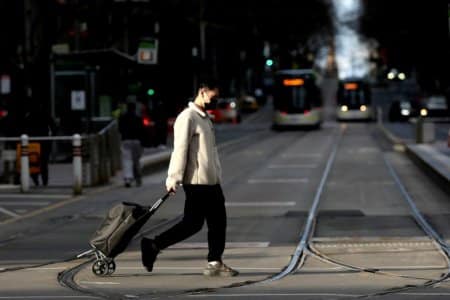
Many would love to work in Australia.
There are numerous positive things that come to mind when you think of this country: vegemite, koalas, kangaroos, and blond Adonis-looking people (specifically Chris Hemsworth).
If you find this list enticing, you should know that the Australian government has revamped its graduate visa system.
This is part of the government’s “Migration Strategy,” which features eight key actions to overhaul the migration system. One of them, in particular, focuses on international education.
With this strategy, the government is hoping that graduates can help fill the country’s skill shortage.
Still, the package of measures that will be put in place may make it harder for just anyone to apply for an Australian visa.
Key features of migration strategy
The main objectives of the migration strategy are:
- Supporting productivity growth
- Addressing the impacts of an ageing population
- Meeting skills needs
- Strengthening export industries
- Complementing the employment, skills and experience of local workers
- Supporting wage growth for all workers
- Preventing the exploitation of migrant workers
- Providing clear pathways to permanent residence
- Supporting a well-managed migration intake
- Building a cohesive, multicultural society
- Supporting relationships with family abroad
Some elements of the new migration strategy directly impact international students:
- Increase the International English Language Testing System (IELTS) score (or equivalent) required for a Temporary Graduate Visa and Student Visa from 6.0 and 5.5 to 6.5 and 6.0, respectively
- Apply greater and more targeted scrutiny to student visa applications from high-risk providers
- Bolster the student visa integrity unit in the Department of Home Affairs to reduce misuse of Australia’s student visa system
- Strengthen requirements for international education providers
- Restrict onshore visa hopping that undermines system integrity and drives “permanent temporariness”
- Strengthen and simplify Temporary Graduate visas.
- Closing the loophole that allowed international students to switch to lower-quality education providers so that they could work in Australia ahead of study
- Increase the amount of savings international students will need to be eligible for student visas.
How long international students can stay to work in Australia after graduating has also changed:
- Two years for graduates of bachelor’s degree (no change)
- Two years for graduates of master’s by coursework (reduced from 3 years)
- Three years for graduates of master’s by research (no change)
- Three years for PhD graduates (reduced from 4 years)
Would this make applying for an Australian graduate visa much harder or make it tougher to work in Australia?

The Australian Graduate Visa lets you live, work and study in Australia temporarily. Source: AFP
Hardest countries to get a visa
Securing a student visa is a key step for those aspiring to study abroad, and the process often requires meticulous preparation.
One fundamental requirement is an acceptance letter from a recognised university.
You must also prove that you can cover tuition, living expenses, and other related costs. This often involves presenting bank statements, scholarship details, or financial sponsorship letters.
Another essential element is a passport valid for a minimum of six months beyond the intended period of stay.
Health insurance is often mandatory, ensuring students have access to medical care during their time abroad.
Some countries may also require proof of proficiency in the language of instruction, like English language proficiency tests.
In some countries, student visa application processes are quite straightforward. In fact, Australia is one of the easiest countries to get a student visa.
Other countries on this list include:
- Germany
- New Zealand
- Canada
- UK
- US
Some countries require a lot more work and documentation, making it much harder to obtain a student visa.
Here are some of the hardest countries to get a student visa:
- China
- Iran
- Saudi Arabia
- Nigeria
- Pakistan
- Bhutan
- Malta
- Sweden
- Belgium
- France
- Norway
Why does everyone want to work in Australia?
The top reason? Life’s good. Australia has one of the highest standards of living in the world.
Life expectancy at birth was 81.2 years for males and 85.3 years for females from 2020 to 2022, according to the Australian Bureau of Statistics.
Australia’s world-class education industry boasts numerous prestigious universities, with nine ranking among the top 100 globally.
Plus, its healthcare system is top-notch. Australia’s medicare scheme offers free treatment in public hospitals and subsidised medical services from doctors, specialists, and other healthcare professionals.
Given these factors, it’s not surprising to see why many international graduates make it a goal to work in Australia — some even going so far as to consider applying for permanent residency.
But there are four reasons why getting more skilled international graduates into jobs requires more than just an extension of a student visa:
- Up to one-third of international graduates who stay in Australia upon completing their studies are still unemployed six months after graduating. Full-time employment rates for international graduates are also consistently lower than for local graduates — 43% versus 68.9% in 2021.
- Securing well-paying jobs in occupations related to a student’s field of study takes time. Many students and graduates report they are taking jobs that are not related to what they have studied — and often for low wages. Even if international students with an undergraduate degree find full-time employment, studies show they earn 20% less than local graduates.
- Employers were hesitant to hire international graduates on temporary visas, according to a 2020 Deakin University report. Other research shows employers favour those with permanent residency because they see them as more likely to stay in Australia and are worth the investment in recruiting and training.

Australia is a nation shaped and invigorated by the diverse cultures and talents of millions of migrants. Source: AFP
What else should I know about the Migration Strategy?
The Migration Strategy was designed to ensure migrants fully enjoy the benefits of living and working in Australia and are not vulnerable to exploitation.
It is also designed to give Australian workers confidence that their own wages and conditions are protected, and to give employers confidence that they will be supported if they do the right thing.
A theme listed in this document is the tagline of “getting migration working for the nation. For workers. For businesses. For all Australians.”
Australia is a nation shaped and invigorated by the diverse cultures and talents of millions of migrants.
The government calls the current migration system “broken” ”
“We see too many instances of migrant worker exploitation. There are too many back doors and side doors into the system, undermining the system’s integrity,” wrote Clare O’Neil MP (Minister for Home Affairs Minister for Cyber Security) and the Honorable Andrew Giles MP (Minister for Immigration, Citizenship and Multicultural Affairs).
“There is insufficient regard for pressures on housing and infrastructure. And the skilled people we need are turned off by a complex, unworkable system.”
Apart from one key action to overhaul the migration system that focuses on international education, other measures include:
- Targeting temporary skilled migration to address skills needs and promote worker mobility: A new Skills in Demand visa with three targeted pathways and visa settings that encourage migrant worker mobility in the labour market.
- Tackling worker exploitation and the misuse of the visa system: A comprehensive suite of legislation, powers, penalties, and policies to combat worker exploitation and restore integrity to the migration system.
- Simplifying the migration system to improve the experience for migrants and employers: A system-wide simplification agenda that will streamline visa settings, reduce visa classes, and make the system easier to use.










